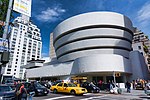1973 New York City bomb plot
1973 in New York CityBlack September OrganizationCar and truck bombings in the United StatesExplosions in 1973Failed terrorist attempts in New York City ... and 3 more
Terrorist attacks attributed to Palestinian militant groupsTerrorist incidents in North America in 1973Terrorist incidents in the United States in the 1970s
The 1973 New York City bomb plot was a plan by the Palestinian militant group Black September to detonate three car bombs in New York City at the same time Israeli Prime Minister Golda Meir arrived there in March 1973. The bombs failed to explode, but the main suspect, Khalid Duhham Al-Jawary, was not caught until January 1991. The attempted attack was the first such Black September operation within the United States.
Excerpt from the Wikipedia article 1973 New York City bomb plot (License: CC BY-SA 3.0, Authors).1973 New York City bomb plot
5th Avenue, New York Manhattan
Geographical coordinates (GPS) Address Nearby Places Show on map
Geographical coordinates (GPS)
| Latitude | Longitude |
|---|---|
| N 40.782846 ° | E -73.959459 ° |
Address
5th Avenue 1069
10128 New York, Manhattan
New York, United States
Open on Google Maps








